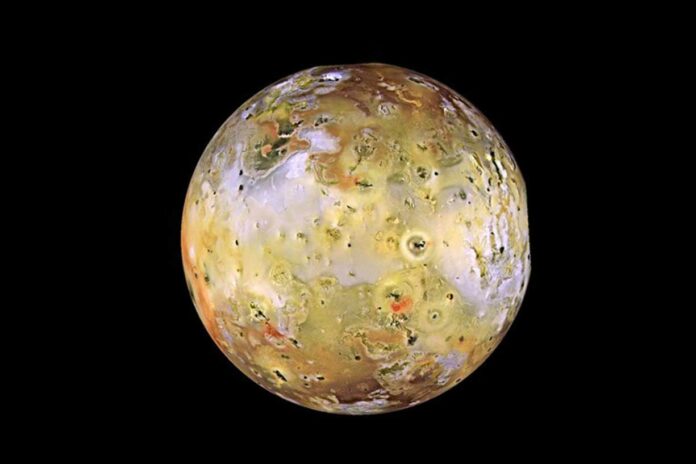Io, Europa, and Ganymede are Jupiter’s moons arranged in orbits. Due to the gravitational pull between these moons, their orbits are elliptical rather than circular. On such orbits, Jupiter’s gravity can warm the moons’ interiors, contributing to the volcanism of Io and warming the liquid ocean beneath the frozen surface of Europa.
How long has volcanic activity been going on in Io?
The most volcanically active location in the solar system is Jupiter’s moon Io, claims a recent study by a group of planetary scientists and geologists from NASA Goddard Space Flight Center, the University of California Santa Cruz, New York University, and the California Institute of Technology. It has been volcanically active for billions of years- almost 4.5 billion years.
Scientists measured the isotopes of sulfur found in the atmosphere of Io. Io’s inventory of volatile chemical elements, such as sulfur and chlorine, has an isotopic composition that records its evolution by reflecting its mass loss and outgassing history.
They also discovered that the moons Io, Europa, and Ganymede have been tidally engaged in a resonant dance known as Laplace resonance for billions of years.
Scientists analyzed the chemicals present in the atmosphere of the Jovian moon to ascertain the duration of the volcanism.
Since Io doesn’t have enough water, sulfur is the most prevalent material that erupts from its volcanoes. Sulfur compounds generate an environment that is 90% sulfur dioxide. The gases close to the surface are reabsorbed into the interior and re-emerge into the atmosphere throughout Io’s dynamic volcanic cycles.
Another fact is that Io has several isotopes or types of sulfur atoms. Heavy isotopes are more likely to be at the bottom, close to the moon’s surface, whereas lighter isotopes are more likely to be at the top.
Jupiter’s atmosphere and surface are leaking into space at a rate of 1 ton per second as a result of collisions with charged particles in its magnetic field. The lesser sulfur isotope, sulfur-32, is depleted proportionally to its heavier counterpart because it is more prevalent at the top of the atmosphere, where these collisions occur. Determining the extent of the absence of light sulfur can provide information about how long the moon has been volcanic.
To achieve this, the scientists measured the sulfur isotopes on Io using the ALMA (Atacama Large Millimeter/Submillimeter Array) telescope in Chile, which is surrounded by volcanoes.
About 23 sulfur-32 atoms for every sulfur-34 atom formed during the solar system’s formation. Io would have the same ratio now if it hadn’t altered since then. According to a recent study, the moon has lost between 94 and 99 percent of its original sulfur, implying that it has been volcanically active for billions of years while continuously losing sulfur to space.
The length of Io’s volcanism suggests that the moon formed relatively soon after Europa and Ganymede locked into an orbital resonance. According to simulations that have been running for the past twenty years, the Galilean moons—Io, Europa, and Ganymede—should reach this resonance fairly early after their creation, confirming those predictions.
Katherine de Kleer, assistant professor of planetary science and astronomy and Hufstedler Family Scholar, said, “The Jovian system is just one of many examples of moons, and even exoplanets, that occur in these types of resonances. The tidal heating caused by such resonances is a major heat source for moons and can power their geological activity. It is the most extreme example of this, so we use it as a laboratory for understanding tidal heating in general.”
Scientists created a sophisticated model of Io’s sulfur system in one study. This allows them to determine potential scenarios for the moon’s history, including some in which Io was even more volcanically active in the past than it is today.
Former Caltech postdoctoral scholar Ery Hughes said, “Because lots of the light sulfur is missing, the atmosphere we measure today is relatively ‘heavy’ in terms of sulfur. The key to achieving such heavy sulfur in Io’s atmosphere is burying the heavy sulfur back into Io’s interior, so that it can be released by volcanoes repeatedly.”
“Our modeling shows that sulfur gets trapped in the crust of Io by reactions between the sulfur-rich frosts, which are deposited from the atmosphere and the magma itself, allowing it to be eventually buried into Io’s interior.”
Scientists are further planning to learn what other gases Io may have lost over the course of its long dynamic history.
Journal References:
- Ery Hughes, John Eiler et al. Isotopic evidence of long-lived volcanism on Io. Science. DOI: 10.1126/science.adj0625
- Ery Hughes, de Kleer, and Eiler et al. Using Io’s Sulfur Isotope Cycle to Understand the History of Tidal Heating. JGR-Planets. DOI: 10.1029/2023JE008086
